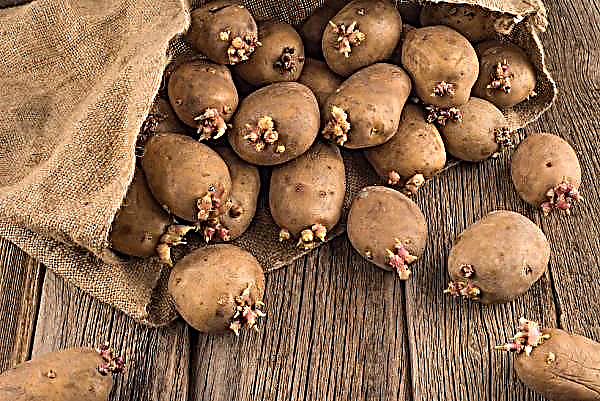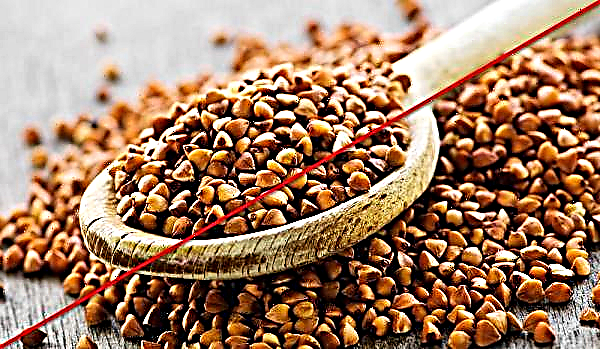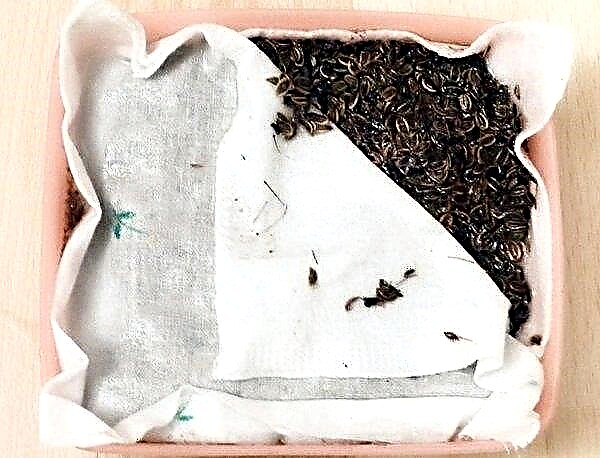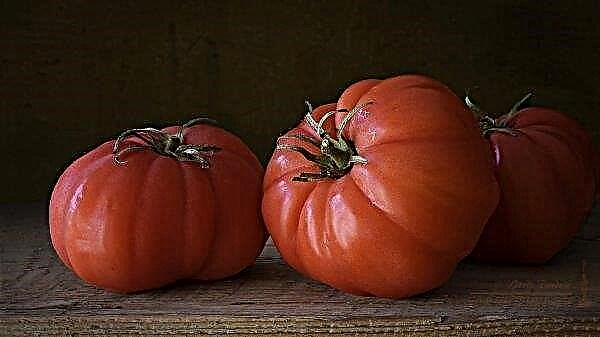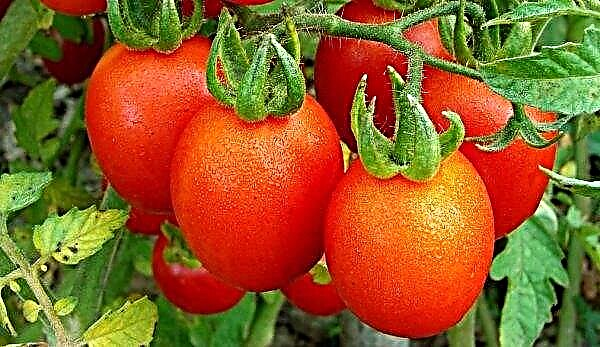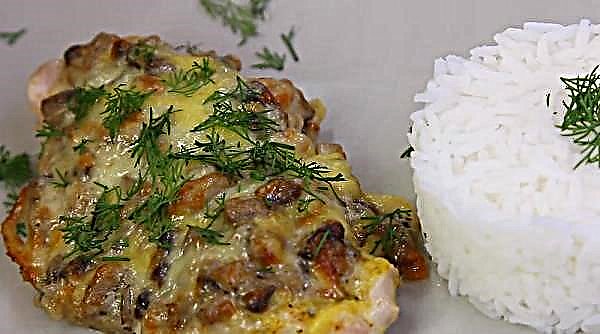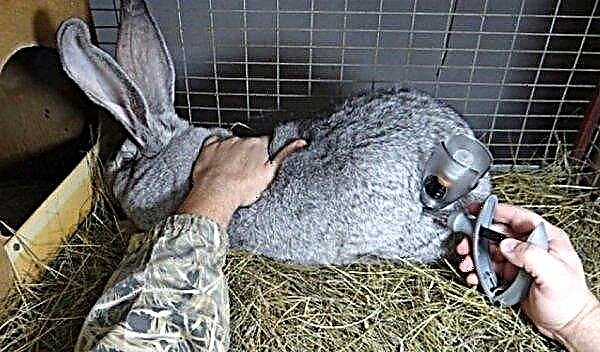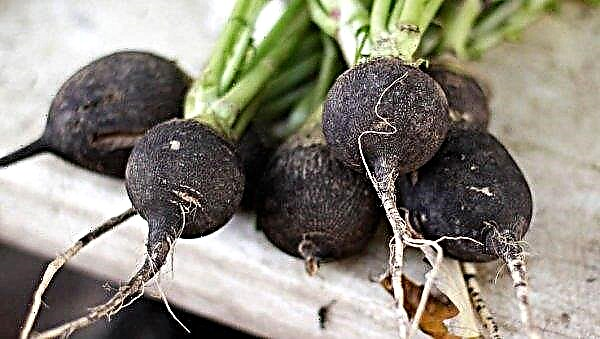Until the eighteenth century, turnip was the main vegetable on the table among the Slavs of Eastern Europe, until this crop was replaced by potatoes. This product can now be used to prepare many dishes. We learn what turnip is, its most popular varieties and how to grow and store it, is it afraid of frost.
The origin and description of turnips
Turnip is a one- or two-year-old plant from the cruciferous family. She consumes fleshy juicy root. Turnip looks like a beetroot, as it is also an edible root crop, only the color of its pulp is mostly yellowish or white.
The skin of this vegetable itself can be not only the color of the pulp, but also green, pink, burgundy, purple. The shape of root crops, depending on the variety, is round, flat-round or elongated.
Turnip comes from West Asia. It belongs to the oldest vegetable crops and has been grown by man for 4 thousand years.
Did you know? The ancient Egyptians and Greeks grew turnips, but considered it the food of slaves and poor. In the Roman Empire, it was consumed by all segments of the population. In Russia, it was the most important vegetable crop.
Popular cultivars
Consider the most common varieties of turnip:
- Petrovskaya. The oldest and most common variety, with an average ripening period (60–65 days) and excellent yield. It forms flat-round root crops with a yellowish color of sweetish pulp. They can be stored for a long time.
- White Night. Mid-season variety with white root vegetables for salad purposes. They reach a pound of weight and are similar in taste to radishes. Suitable for storage.
- May white. Early ripening variety with excellent taste of white pulp. Root crops are not stored.
- Granddaughter. An early variety with small round root crops of yellow color. This turnip has excellent taste and is suitable for storage.
- Geisha. Early ripening variety of salad direction, in which tops are also suitable for food. Root crops of white color, rounded in shape and weighing up to 200 g. They have excellent taste, but are not stored. The variety has resistance to stem.





This is not the whole list of varieties that you can now buy. Now on sale you can find many other varieties of mainly foreign selection. In general, they are divided into early (for seasonal consumption) and late, suitable for storage.
Optimal timing for growing
The timing of sowing turnip seeds depends on its purpose and varietal characteristics. For summer consumption, it can be sown in open ground already in late April and early June. To obtain constant fresh produce in the summer, it is better to sow it at the cottage in stages every 10-15 days.
Seeds of frost-resistant varieties can germinate even at 0 ° C, so they are often sown before winter. Turnip sprouts withstand light frosts (up to -1 ° C), but it is hardly worth using winter crops if in your region there are frequent thaws with returning severe frosts.
In general, temperatures are suitable for this crop when the soil has already warmed up to + 3 ... + 5 ° С, and the air temperature has risen to + 15 ... + 18 ° С. To obtain the earliest production, you can use the seedling method. For seedlings, seeds are sown 6-8 weeks before planting on the beds.
To obtain root crops for winter storage, seeds of suitable varieties are sown in July. At the same time, they are guided by the ripening period of the variety, climatic characteristics of the region and the fact that the seeds germinate up to 10 days.
Did you know? It has long been the best time to harvest turnips in Russia was considered the date of the Orthodox holiday Exaltation, falling on September 27. These dates are well suited for the collection of root crops in the middle zone of the Russian Federation.
For example, for winter stocks, sowing of turnips of the Petrovskaya variety should be done in mid-July to grow it to frost, since it is harvested on the 60–80th day from the appearance of seedlings.
Basic rules for growing turnips
This culture is not afraid of spring light frosts, and it can be grown in all regions on different types of soils.
Growing seedlings
Turnips for seedling material are sown 1.5–2 months before planting in a permanent place. First you need to prepare the seed material and discard the seeds with voids, as well as signs of deformation and damage. To do this, they need to be placed in a saline solution (5 g of salt per 100 ml of liquid) and mix.
Poor material will float to the surface, and good seeds will settle to the bottom.
Then, a disinfection process should be carried out in order to avoid the appearance of many diseases in the future. For this purpose, warming up in hot water is carried out. Seed should be put in a gauze bag, and then immersed in a thermos with water, which is heated to + 55ºC, for 20 minutes.
Then the bag is pulled and dipped in cool water for a couple of minutes. This procedure can be replaced by disinfecting the seed in a solution of manganese (2 g per 100 g of water). Seeds are dipped in such a solution for 20 minutes. Then the seeds should be soaked for peeling for several days. In this case, water needs to be changed 2 times a day.
Turnip sprouts normally tolerate crowding, so they can be sown densely, but for the convenience of further planting in the soil, it is good to sow the seeds in special peat tablets. Sowing should be closed with a plastic bag and put in a lit place, but without direct sunlight. After the appearance of the sprout, the package is removed. Every day the package is opened for airing for 15 minutes.
Every day the package is opened for airing for 15 minutes.
Important! Dip seedlings of turnip is not worth it, and therefore it is best to immediately put it in a separate container. She does not tolerate the transplant very well, since such a procedure is for her — excess stress.
A feature of growing seedlings is that the optimum temperature is + 5 ... + 15ºC, so a balcony, loggia or porch is well suited for this purpose. When the seedlings sprout, weak specimens can be removed so that they do not draw moisture and nutrients onto themselves.
Further, the care of seedlings is similar to the care of any seedlings - watering, loosening, top dressing. 14 days before planting in the soil, seedlings should be hardened. To do this, the seedlings are taken to fresh air. First, for several hours, and then increase the time. When the seedlings remain in the fresh air for whole days, it can be planted in a permanent place.
Preparation of a plot for planting seedlings
Landing site is prepared in the autumn. It should be noted that turnip does not grow on heavy clay soils, since its roots need good aeration for normal formation. Such land is improved by the introduction of sand, ash, straw and brick chips.
The main requirements for a turnip growing site are light nutrient soils that are well lit by the sun. It can grow on soils of any acidity, but if the soil is too acidic, then it is better to carry out the liming process, since in the soil with high acidity the fruit will have poor keeping quality.
Lime should be calculated at the rate of 130–150 g of lime per 1 m². For soil alkalization, you can also use wood ash or dolomite flour. You need to choose a place in the garden for planting where legumes, tomatoes, cucumbers, zucchini, and potatoes previously grew. Bad predecessors are lettuce, horseradish, radish, daikon, and especially turnip itself. These cultures have the same pests and common diseases.
You need to choose a place in the garden for planting where legumes, tomatoes, cucumbers, zucchini, and potatoes previously grew. Bad predecessors are lettuce, horseradish, radish, daikon, and especially turnip itself. These cultures have the same pests and common diseases.
The site should be flat or slightly lower for better moisture. The landing site should be well lit and sheltered from the wind.
Important! It is undesirable to apply to the soil fresh manure, root crops will be deformed and lose their taste.
Rules for planting seedlings
An adult plant is not afraid of frosts to -4 ° C, but seedlings should be planted when there is no threat of frost return or plant it in a protected ground. It is recommended to plant it in open beds in the second half of May. Seedlings are planted with an interval of 30 cm from each other. This plant loves space, so planting does not need to be thickened.
Basic care rules
To obtain a high yield, it is necessary to provide the plant with proper care, which consists in observing the basic rules of cultivation agricultural technology - proper watering, weeding, fertilizing, as well as timely control of diseases and insect pests.
Watering
If the summer period is hot enough, then watering should be carried out 2 times in 7 days in the amount of 30 liters per m² of garden. Planted seedlings are first watered with a watering can with a divider, and grown plants can already be watered from a hose with a diffuser. If the turnip is not moistened, then the qualitative characteristics of the plant culture are reduced. Cracks appear in root crops, the fruits become dense, and the taste gives off bitterness, so it is especially important to water turnips during the period of active growth of the fruits, that is, a few weeks before digging from the soil.
If the turnip is not moistened, then the qualitative characteristics of the plant culture are reduced. Cracks appear in root crops, the fruits become dense, and the taste gives off bitterness, so it is especially important to water turnips during the period of active growth of the fruits, that is, a few weeks before digging from the soil.
Top dressing
With sufficiently nutritious soil, it is not particularly necessary to make fertilizing. But to get a good crop, fertilize with rotted manure or bird droppings, as well as a solution of boric acid (concentration of 0.1%). It will not be superfluous to introduce wood ash into the soil - turnips are very fond of such top dressing.
If the soil is not particularly nutritious, then to obtain a large crop it is necessary to fertilize every 10 days using the following solution - for 10 liters a bucket of water is taken in 10 g of ammonium nitrate, potassium chloride and double superphosphate.
Weeding
Be sure to carry out timely weeding turnips. The first thinning is carried out during the formation of several true leaflets. For removal, more underdeveloped specimens are selected, observing a distance between plants of 4–5 cm. After 14–21 days, a second weeding is carried out.
Again weaker specimens are pulled out of the row, leaving 9-10 cm gaps between the plants. During weeding, it is also necessary to loosen the soil and remove weed grass.
Important! On the eve of weeding, the site with planting should be moistened - this will greatly facilitate the process.
The soil on the beds with turnips can be mulched with a layer of 7 cm of straw, sawdust or peat.
Pest and Disease Control
Landings should be carefully inspected for signs of disease or pests. The most common problems with growing are associated with the appearance of bacteriosis (vascular or mucous), rot, downy mildew. In addition, this plant crop may be invaded by cabbage flies, cruciferous fleas, weevils, aphids.
As a preventive measure against the appearance of various diseases and pests, pollination of plantings with such mixtures well helps:
- ash and tobacco dust. 1 to 1 ratio;
- mustard and pepper. 1 to 1 ratio.
Such treatments are carried out 2-3 times with an interval of 7-10 days. As a preventive measure, it is also necessary to observe crop rotation, seed dressing before planting, timely weeding, loosening the soil and removing weeds, removing plant debris and digging in the fall after harvest.
The simplest method of protection, if the flies are spoiled by flies and fleas, is to cover the beds with spanbond or other similar agrofilm.
If fungal diseases are detected, diseased plants should be removed, and chemical preparations such as “Fundazol” and “Topsin” should be used. If there are too many insect pests, treatments are carried out using insecticidal preparations such as Karbofos, Actellik.
Harvesting and storage rules
For storage for the winter, turnip crops are harvested before the onset of autumn frosts. If the root crops undergo freezing due to frost, then their keeping quality drops sharply.
Root crops are pulled out of the soil by hands or undermined with a shovel. Harvested root vegetables sort out and discard damaged specimens. They should not have cracks or mechanical damage. The tops must be removed, leaving the petiole up to 10 mm, the roots cut completely to the base.
Harvested root vegetables sort out and discard damaged specimens. They should not have cracks or mechanical damage. The tops must be removed, leaving the petiole up to 10 mm, the roots cut completely to the base.
No need to put the harvest in the sun, the fruits will begin to wither. If it rained the day before, the dug out root crops should be dried under a shelter, and then moved to the store.
You should know at what temperatures turnip is best stored. The optimal temperature regime for storing these root crops is the range 0 ... + 1ºC, and the optimum humidity is 90%. In this case, it is better to sprinkle root vegetables with sand.
It is best at home to store this root crop in the cellar, basement or balcony. For convenience, you can use boxes, and sprinkle the fruit with sand. Periodically, root crops should be sorted and sorted out spoiled instances.
In the refrigerator in the vegetable department, turnips are stored for no more than a month. Storage takes about 4 months. Turnips can also be dried, canned, salted, frozen. This will increase the shelf life from 6 to 12 months.
Did you know? Turnip is great for vegetable salads, soups, okroshka. You can eat it raw, bake, stew and stuff. In many recipes, it can replace beets.
Turnip is suitable for growing in any region of the country. There are varieties for early consumption, the earliest production of which can be obtained using seedlings.

